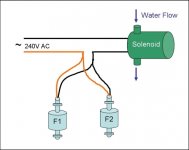Hi all,
While still planning things for my new tank, I am trying to solve a few issues.
1) I need to control a small powerhead that will top-off the sump with RO/DI water (both turning it on when water level is too low and shuting it down when level is too high)
2) Also I need shut-off the two return pumps (EHEIM 1262) in the case something goes wrong with the 2 Durso StandPipes.
So I am resorting to liquid level switches (like the ones here: www.floatswitches.net). Problem is that they are limited as far as the voltage/current needs of the device they control (230V over here in Greece) and watts capacity is also low.
Does anyone has any tried & proven alternatives to propose?
Needles to say that budget is indeed an issue, so the cheaper the better!!!
While still planning things for my new tank, I am trying to solve a few issues.
1) I need to control a small powerhead that will top-off the sump with RO/DI water (both turning it on when water level is too low and shuting it down when level is too high)
2) Also I need shut-off the two return pumps (EHEIM 1262) in the case something goes wrong with the 2 Durso StandPipes.
So I am resorting to liquid level switches (like the ones here: www.floatswitches.net). Problem is that they are limited as far as the voltage/current needs of the device they control (230V over here in Greece) and watts capacity is also low.
Does anyone has any tried & proven alternatives to propose?
Needles to say that budget is indeed an issue, so the cheaper the better!!!






